Leap Day aka Sadie Hawkins Day

A blog post by Education Director Ilene Dackman-Alon. To read more posts by Ilene click HERE.
Today is Monday, February 29, the calendar anomaly better known as Leap Day. As a kid, I always thought that being born on February 29th was pretty cool. Every four years you were able to officially celebrate your birthday, but on the alternative years you could pick any day that you pleased! I remember that in junior high school that there was a Sadie Hawkins Dance that took place on February 29th (also known as Sadie Hawkins Day). For this dance it was considered proper for a girl to ask a boy to the dance, In the 70’s, the whole equality thing had not really caught on yet. I always imagined Sadie Hawkins to be a woman that lived in the Wild West and was sort of brazen, carrying a gun in her boots.
I was surprised to learn that Leap Day was a tradition that originated long ago in Ireland. On this day, women were allowed to ask a man for a date or for their hand in marriage; contrary to the usual tradition of women waiting patiently for men to ask them on a date, or for his hand in marriage. In the United States, the Leap Day phenomenon was documented as early as the 20th century. Slate Magazine features some vintage postcards dedicated to warning men about the hazards of accepting female visitors on Leap Day.

Today the Leap Day custom is kept alive by pop culture, most recently in the Amy Adams 2010 romantic comedy named Leap Year, a film about a woman who heads to Ireland to ask her boyfriend to accept her wedding proposal on leap day, when tradition supposedly holds that men cannot refuse a woman’s proposal for marriage.

I also learned that Sadie Hawkins was not from the Wild West, but she was actually part of U.S. pop culture and she also has Jewish roots.
Surprise!!!! Sadie Hawkins Day was introduced in pen and ink in by Al Capp’s classic comic strip Li’l Abner. In the comic, Sadie Hawkins was a spinster at the age of 35, and her father set up a race for local bachelors. Whoever Sadie caught was going to be her husband. The town, and the reading audience loved the idea and the race became an annual fixture of the comic strip, and soon spread into real-life society, spawning Sadie Hawkins Day dances.

According to Wikipedia, Sadie Hawkins Day is a pseudo-holiday entirely created within the comic strip. It made its debut in Li’l Abner on November 15, 1937. Capp originally created it as a comic plot device, but in 1939, only two years after its inauguration, a double-page spread in Life proclaimed, “On Sadie Hawkins Day Girls Chase Boys in 201 Colleges.” By the early 1940s the comic strip event had swept the nation’s imagination and acquired a life of its own. By 1952, the event was reportedly celebrated at 40,000 known venues. It became a woman-empowering rite at high schools and college campuses, long before the modern feminist movement gained prominence.
Al Capp, the creator of Li’l Abner was born in New Haven, Connecticut in 1909. His parents, Otto Caplin and the former Matilda Davidson, were both American-born, but their parents were Jewish immigrants from Eastern Europe. His father’s family hailed from the Lithuanian village of Yanishok.
When he was nine, Capp was pinned under a New Haven streetcar while on his way to a haircut, requiring the amputation of his left leg above the knee. His father was an amateur cartoonist and taught his son about the foundations of drawing during his recuperation.
Capp (he shortened his name so that it would fit inside within the cartoon panel of “Li’l Abner”) never finished Bridgeport High School, but decided early on that he wanted to become a cartoon artist. He attended three different art schools – and was expelled from each when he failed to pay tuition.
In 1932, Capp went to New York and began knocking on doors. Once he began to get work there was no stopping him. By 1934, Capp had devised the concept of a comic strip about the residents of an imaginary town in the American South that he called Dogpatch, which he sold to United Features Syndicate. “Li’l Abner” premiered on August 13, 1934, and ran until November 1977. At its peak, it appeared in 900 papers domestically and more than another 100 overseas.

In terms of both popular success and critical acclaim, Capp may well have been the most accomplished American cartoonist of the 20th century. In 1953, novelist John Steinbeck suggested that “Capp may very possibly be the best writer in the world today.” Sadie Hawkins Day and Sadie Hawkins dance are two of several terms attributed to Al Capp that have entered the English language.
I am not sure if there are Sadie Hawkins dances anymore –but I thought it was interesting to learn that Al Capp, a Jewish cartoonist, was responsible for coining a phenomena that was such an important part of American culture during the 20th century.
